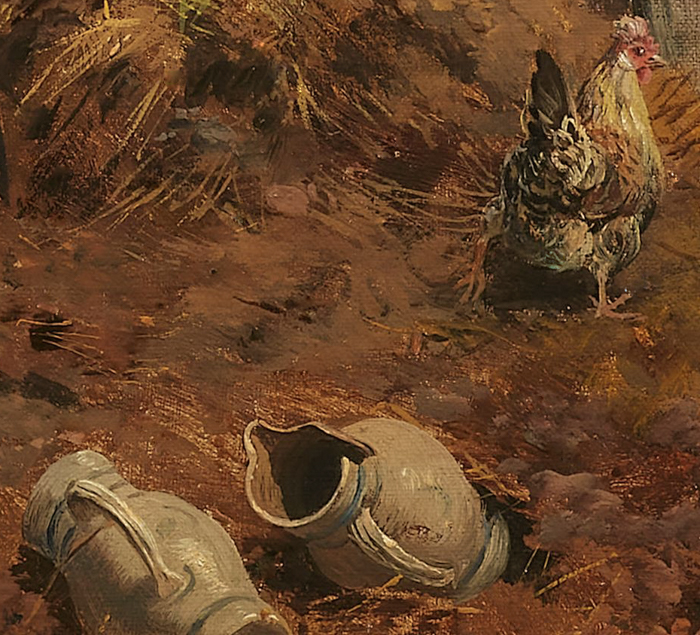

Before We Make a Roux
Mr. Brian D. Miller

"To every thing there is a season, and a time to every purpose under the heaven: A time to be born, and a time to die; a time to plant, and a time to pluck up that which is planted."
I extend my hand to shield the cool autumn light and search the skies encircling the rising sun. In perfect V formation, a skein of honking geese flies high over our East Tennessee farm, heading south to warmer climes and the probability of waiting guns on the waters of Alabama. Autumn is the season of dying beauty. It rings in the last of the gardens and the salvaging harvest. It signals the slaughter of the fatted pig, the maturing cockerels, and the spring lambs. It is the time of the hunter, his echoing shots heard at dawn, the time when the deer, geese and turkeys, squirrels and rabbits become fair game for the larder and the table.
Come harvest day on the farm, first a dozen cockerels, then one fat Pilgrim goose, and finally the truly beautiful three-year-old Speckled Sussex rooster take their turn with the freshly sharpened blade. My beloved and I work together as a team, forty years of learning the values of routine and process behind us. She wrangles the waiting birds and I wield the knife. I scald while she works the plucker. She picks the few feathers remaining, and I eviscerate, dumping the offal in a waiting tub. All the while the dogs wait not so patiently at our feet, hoping to be favored with a foot or discarded organ.
After evisceration, we carry the tubs of birds to the house to wash and bag for the freezer. I return to the place of butchering and clean the table and equipment. Once done, I take a break by the large elderberry next to the smokehouse, where I light my pipe. I think about the raising, the death, the food, our life together. Farming teaches you, sometimes painfully, a fine appreciation for the links and cycles of life. I sit and smoke, recalling another autumn, when we buried my father at age ninety-four. I muse on how fitting it was that sad day that on the following day one of his granddaughters gave birth.
My thoughts soon turn to how to make best use of the birds. The answer when it comes to the Sussex rooster is perfectly clear: a rich, deep brown gumbo done in Southwest Louisiana fashion. A true and proper gumbo can take years in the making. Like a coq au vin, a traditional gumbo is best made with a bird with plenty of age and muscle. While a six-month cockerel will do a serviceable job in the pot, it is the spent rooster that delivers the fullest flavor. (Flabby nine-week-old commercial birds need not apply.) There is still no rush. After all, from chick to breeder to old bird, the final dish has already taken years. This rooster will be honored in his own due time. We will wait for the perfect evening — an intimate gathering of friends or family — before we get down to the business of cooking the gumbo, that is, by making a roux.

There is still no rush. After all, from chick to breeder to old bird, the final dish has already taken years. This rooster will be honored in his own due time.

In the years after my mother passed away when I was three, we often visited her parents in Crowley, Louisiana. Crowley was a town perched on the edge of the great inland prairie where the best rice was grown, and still is. Just south of there, on Bayou Tortue, is where my mother’s family bought land from the Atakapa Indians in the 1700s. (And then, as a warning to all, the latter, birthright sold, disappeared into the mists, as we all do when we leave the land.) It was the Atakapa who gave us the tradition of using gumbo filé, ground sassafras leaves used on occasion as a thickener in and, more often, as a garnish on dark-roux gumbo of chicken and sausage.
When I knew my maternal grandparents, in the 1960s, they lived in a modest home off the main street. Their shaded house had a back hallway that had been blocked off to create a small apartment that was rented to a mysterious woman whom I never saw. My grandfather had farmed rice at the turn of last century before losing everything to the Great Depression. After selling three hundred and fifty-nine acres of Early Prolific and Blue Rose rice in 1929, the family had just $200 left once it paid off its loan to the Federal Land Bank. That was the last year my grandfather farmed his own land. The year before she died at one hundred, my aunt could still describe to me the bound shocks of harvested rice standing in the fields.
The front porch of the Crowley house was screened from mosquitoes and curious passersby. The front yard had two large live oaks and one palm tree. The house was only a couple of blocks from a five-and-dime. My grandfather would walk me and my brother down the quiet street, holding our hands, while Meemaw prepared a slow-cooked gumbo for dinner. Granddaddy would give us a dime, and both my brother and I would purchase a three-piece balsa wood plane sold in a flat pack. Back down those lazy streets we would then walk, shaded by the spreading oaks leading to my grandparents’ yard, where, once home, we would assemble and fly our planes until we were called to dinner.
Forever fixed in my mind is the belief that the making and serving of gumbo starts with the act of love. Once you understand that, it takes little imagination to know that Meemaw’s first step in preparing that Sunday dinner of gumbo for my family in the small tree-shaded house in Crowley came long before its actual undertaking; it began when she was a small child, sitting down with her family to fragrant bowls of gumbo in the late 1800s.
Her second step took place the day before the cooking got underway, on a Saturday morning. That’s when an elderly black woman came to the kitchen door selling chickens, freshly butchered, for that Sunday’s dinner.
Years after Granddaddy’s death, Meemaw moved to Beaumont, Texas, to live with a daughter. More memories, more dinners with family, always the same delicious dish (did we ever eat anything else?): chicken and sausage gumbo, accompanied always by green onions in a Mason jar, a plate piled high with white bread, and plenty of butter and whole fig preserves on the side. My grandmother would be in the kitchen cooking and laughing with the family maid, the combined aroma of onions, roux, and chicken drifting out to stimulate the appetite of her waiting guests.
At my homeplace in Lake Charles, Louisiana, my own father’s gumbo-making started with duck-hunting season, in the autumn, out on the marsh. His gumbo was built around wild mallard and smoked sausage, a dish he prepared for the family for Saturday dinners. (Dinner, in the South, is the big meal of the day. You can have dinner on a Saturday evening or Sunday afternoon after services, a distinction only confusing to the regionally unchurched.)
Gumbo is fundamentally a rural dish, one created from the harvest, whether it be raised or hunted. And, as all know, God stops at the city gates. Which explains why in the crescent city of New Orleans, where his absence is most keenly felt in the light brown dish they choose to call “gumbo,” you will find okra swimming in an undercooked roux. New Orleans gumbo is a heresy.
Again, gumbo is not to be rushed, and it should never be eaten in a restaurant — unless, of course, it’s at a roadside joint at lunch, preferably washed down with a longneck Dixie beer. Gumbo is a dish that is always in the making. It has no fixed starting point but the land and home: from the filé made of sassafras leaves from the lost Atakapa, to the Blue Rose rice shocked and gleaming gold in the fields, from your grandmother’s purchase of a rooster at the kitchen door to your father’s hunting of ducks on a cold and foggy marsh, to the butchering of an aging rooster by a the father’s grown-up son. A gumbo is not the mere nourishment of our physical needs; it is an act of love that spans time and generations. And that is why, when I fix and serve gumbo to guests of our farm, I reserve a place at the table, at least notionally, for those who have now passed.

